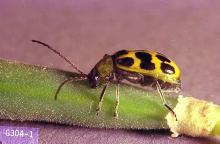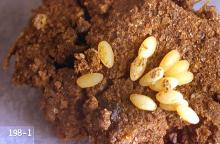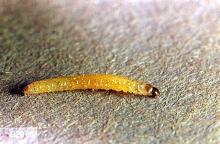Includes
Western spotted cucumber beetle (Diabrotica undecimpunctata)
Western striped cucumber beetle (Acalymma trivittatum)
Pest description and crop damage The western spotted cucumber beetle is yellowish green, 0.25 inch long, and has 11 black spots on its wing covers. Mature larvae are white and about 0.62 inch long. The head and last abdominal segment are dark brown. A close relative, the western striped cucumber beetle, is yellowish and has three black lines down its back. The larvae live in the soil where they feed on roots, but adults are foliage and flower feeders. Cucumber beetle adults eat small holes in the leaves and flowers of many crops. Larvae feed on roots and bore into the base of stems.
Biology and life history Cucumber beetles overwinter as fertilized adults and are active beginning in early spring. Adults lay eggs at the base of plants. Eggs hatch in 7 to 10 days, and larvae feed in roots for about 3 weeks before pupating in the soil. Adults emerge in 2 weeks and begin feeding on pollen. As soon as they hatch, larvae begin to feed on plant roots. They complete their development in the soil. It takes 30 to 60 days to complete a life cycle. There are two generations a year.
Pest monitoring Specific treatment thresholds have not been established for these foliage feeders. Late-year infestations are insignificant. If numbers are damaging during mid-year, excessive foliage loss may reduce crop production. In Virginia, the recommendation is to prevent cucumber beetle damage to seedlings by treating when population reaches 1 beetle per 10 row ft.
Management-cultural control
Commercial row crop covers provide good protection from cucumber beetles, and in addition provide late frost protection and help in moisture retention. Sometimes, the timing of a crop planting can be delayed until after beetles have dispersed and deposited most of their eggs. Delaying planting until warmer weather also gives crops a greater chance of outgrowing beetle injury. Trap crops sometimes can be used to draw beetles away from the main crop. Trap cropping is an unproven control method in Oregon.
Management-chemical control: HOME USE
Apply when beetles first appear and repeat at 7- to 10-day intervals as needed.
- acetamiprid
- azadirachtin (neem oil)-Some formulations are OMRI-listed for organic use.
- bifenthrin (usually as a mix with zeta-cypermethrin).
- carbaryl
- cyfluthrin
- deltamethrin
- esfenvalerate
- imidacloprid
- kaolin-Applied as a spray to foliage, it acts as a repellent to some insect pests. Some formulations are OMRI-listed for organic use.
- malathion
- permethrin
- pyrethrins-Some formulations are OMRI-listed for organic use.
- zeta-cypermethrin
Note: Pesticides can injure cucurbits. Be sure foliage is dry at the time of application.
Management-chemical control: COMMERCIAL USE
- acetamiprid (Assail 30SG) 0.047 to 0.1 lb ai/A. PHI 0 days. REI 12 hr. Retreatment interval 5 days. Do not exceed 5 applications or 0.5 lb ai/A per season.
- alpha-cypermethrin (Fastac EC) at 0.0175 to 0.025 lb ai/A. PHI 1 day. REI 12 hr. Retreatment interval 7 days. Do not exceed 0.075 lb ai/A per season.
- beta-cyfluthrin (Baythroid XL) at 0.019 to 0.022 lb ai/A. PHI 0 days. REI 12 hr. Do not exceed 0.088 lb ai/A per season. Retreatment interval 7 days.
- bifenthrin (Brigade WSB, Sniper) at 0.05 to 0.1 lb ai/A. PHI 3 days. REI 12 hr. Do not exceed 0.3 lb ai/A per year. Do not make more than two applications after bloom. Retreatment interval 7 days.
- bifenthrin/ zeta-cypermethrin (Hero EW) at 0.04 to 0.1 lb ai/A. PHI 3 days. REI 12 hr. Retreatment interval 7 days. Do not exceed 0.4 lb ai/A per season. Limit 2 treatments after bloom.
- carbaryl (Sevin 4F) at 1 lb ai/A. PHI 3 days. REI 12 hr. Retreatment interval 7 days. Do not exceed 6 lb ai/A per year. Phytotoxic under certain conditions.
- chlorantraniliprole/thiamethoxam (Voliam Flexi) at 0.1 to 0.175 lb ai/A. PHI 7 days. REI 12 hr. Retreatment interval 7 days. Do not exceed 0.172 lb ai of thiamethoxam or 0.2 lb ai of chlorantraniliprole per acre per growing season.
- clothianidin (Belay) at 0.05 to 0.067 lb ai/A foliar or 0.15 to 0.2 lb ai/A soil band, in-furrow, sidedress, drench, chemigation. PHI 7 days foliar, 21 days soil. REI 12 hr. Retreatment interval 10 days foliar. Do not exceed 0.2 lb ai/A per season.
- cyfluthrin (Tombstone) at 0.038 to 0.044 lb ai/A. PHI 0 days. REI 12 hr. Retreatment interval 7 days. Do not exceed 0.175 lb ai/A per season.
- deltamethrin (Delta Gold) at 0.018 to 0.028 lb ai/A. PHI 3 days. REI 12 hr. Retreatment interval 3 days Do not exceed 0.168 lb ai/A per season.
- dinotefuran (Scorpion 35SL) at 0.05 to 0.18 lb ai/A foliar or 0.23 to 0.27 lb ai/A soil. PHI 1 day foliar, 21 days soil. REI 12 hr. Retreatment interval 7 days. Do not exceed 0.266 lb ai/A foliar or 0.532 lb ai/A soil per season.
- esfenvalerate (Asana XL) at 0.03 to 0.05 lb ai/A. PHI 3 days. REI 12 hr. Do not exceed 0.25 lb ai/A per year.
- gamma cyhalothrin (Declare) at 0.01 to 0.015 lb ai/A. PHI 1 day. REI 24 hr. Retreatment interval 5 days. Do not exceed 0.09 lb ai/A per season.
- imidacloprid (Admire Pro) at 0.25 to 0.375 lb ai/A. Soil application only. PHI 21 days. REI 12 hr.
- lambda-cyhalothrin (Warrior II) at 0.02 to 0.03 lb ai/A. PHI 1 day. REI 24 hr. Retreatment interval 5 days. Do not exceed 0.18 lb ai/A per year.
- lambda-cyhalothrin/thiamethoxam (Endigo ZC) at 0.064 to 0.072 lb ai/A. PHI 1 day. REI 24 hr. Retreatment interval 5 days. Do not exceed 0.18 lb ai/A lambda-cyhalothrin or 0.172 lb ai/A of thiamethoxam per season.
- methomyl (Lannate SP) at 0.45 to 0.9 lb ai/A. PHI 1 day at 0.45 lb ai/A or 3 days if over 0.45 lb ai/A. REI 48 hr. Limit 12 treatments per year. Do not exceed 5.4 lb ai/A per year.
- novaluron (Rimon 0.83EC) at 0.06 to 0.078 lb ai/A. PHI 1 day. REI 12 hr. Retreatment interval 14 days. Do not exceed 0.23 lb ai/A per year.
- thiamethoxam (Actara) at 0.047 to 0.086 lb ai/A. Suppression only. Apply high rates for heavy infestations. PHI 0 days. REI 12 hr. Minimum interval between treatments 5 days. Do not exceed 0.172 lb ai/A per season.
- thiamethoxam (Platinum) at 0.078 to 0.172 lb ai/A. Suppression only. PHI 30 days. REI 12 hr. Do not exceed 0.172 lb ai/A per season. Apply to the soil as in-furrow spray, band application, drench, shanked or with irrigation. Platinum and Actara have the same active ingredient; for resistance management, do not follow one with the other.
- zeta-cypermethrin (Mustang) at 0.028 to 0.05 lb ai/A. PHI 1 day. REI 12 hr. Do not exceed 0.3 lb ai/A per year. Retreatment interval 7 days.
Note: Pesticides may injure cucurbits. The possibility of injury is less when foliage is dry at time of application.




